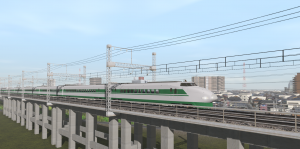
All the necessary dependencies are either included in this .rar or are avaible on the DLS.
DOWNLOAD
These were six 16-car sets (classified as “H-Formations” H1 to H6) ordered in 1990 by the then newly-formed JR East to replace the “E-Formations” wich dated back to the Tohoku Shinkansen opening in 1982, but had suffered from serious metal fatigue and precocious wear and tear (a common problem also with most of the “early” 0 Series formation for Tokaido Shinkansen services, on wich the 200 Series was based), and to “speed up” services on the same line with the introduction of “Super Yamabiko” services between Tokyo and Morioka, running at a maximium speed of 240 Km/h.
Early plans called for trains almost identical to the lastest batch of 200 Series trains then in service (the G-Formations of 1987), but to reduce costs, and to improve the image of the Tohoku Shinkansen, JR East ultimately opted for trains very similar to the already in-production 100 Series for Tokaido Shinkansen services, whose project was to be modified and adapted for the harsher northern japan climate.
Among those modifications, the most notable ones are the small-type passenger windows and the fitting of a skirt to protect the undercarriage electric equipment and the fitting of air deflectors to protet the rooftop electrical connections between carriages.
However, for the sake of maintainance simplicity, the electrical and other tecnical equipment was almost identical to the one used on older 200 Series trains.
Finally, the H-formations kept the same livery design as the 100 Series, obviously with the Tohoku Shinkansen’s green in place of the Tokaido Shinkansen’s blue.
Built by Tokyu Car Co., the first of the H-formations entered service on the 23rd of June 1990, with the deliveries of the other five sets being completed in late July of the same year. By early August 1990, all six H-formations were in service.
Unfortunately, by the early 2000s, the H-formations began to show the same signs of precocious metal fatigue and wear of their predecessors, and therefore, a replacement was inevitable.
With the entry in regular service of the E2-1000 Series in November 2001, the fleet of the 200 Series H-formations started to become thinner by the year, with regular services of the latter being curtailed on the 13th of March 2004, but due to a temporary shortage of rolling stock, two of the sets “in the best shape” (H4 and H5) were re-introduced on the Tohoku Shinkansen shortly after, and were definitely retired in mid-2005.
